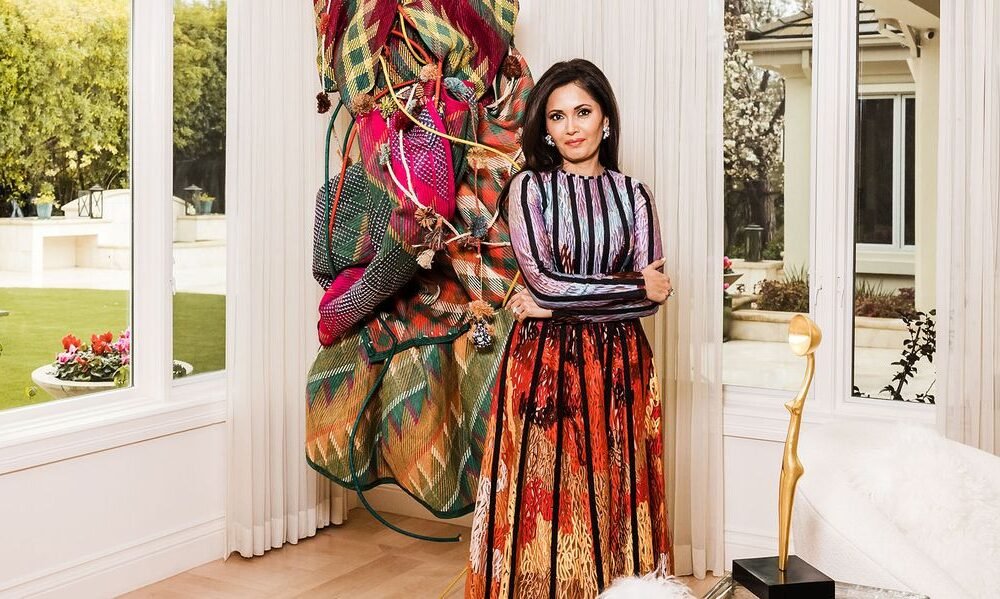
How to Live with Art, According to Collector and Advocate Komal Shah
Above: Komal Shah standing in front of a sculpture by Acaye Kerunen, with a sculpture by Simone Leigh on the table, in the living room of the Shah Garg residence. All images courtesy the Shah Garg collection.
Komal Shah started collecting art just 10 years ago and recalls being too nervous at her first auction to even pick up the paddle. “I ended up asking my friend to do it, because no one else was bidding for the work. I thought, Oh my God, this is a steal,” she says.
While that was her first and last visit to the auction house floor (she prefers to call in), the Rina Banerjee piece she won, It rained so she rained, still has pride of place in her breathtaking California estate. And all these years later, it’s in great company. Making Their Mark is a new book, out now from Gregory R. Miller & Co., that celebrates the work of Banerjee alongside 135 other women artists featured in the expansive collection Shah has built with her husband, investor Gaurav Garg. Getting to this place took a lot of patience, practice, and dedication. “The collection itself has a voice now,” Shah says. “It’s almost easier to say things belong or don’t belong to it.”
We caught up with Shah to talk about how she’s so quickly built the Shah Garg collection into the force it is today (she’s already working with Cecilia Alemani, curator of last year’s Venice art biennale, on an exhibition set to open in New York City in October), and how she’s created a home that’s a platform not just for beautiful artworks, but also for the artists themselves.
ELLE DECOR: It’s interesting to hear you say that the collection now has its own voice, that you know what does and doesn’t fit. How did you get it to that place?
Komal Shah: My work background is in the tech world. All of my bosses have been men, 95 percent of my reports have been men—I learned to love beer within the first two years of coming to the U.S. because we all would go out on Friday and just talk over beer. Once I started thinking about collecting works by women, it was important that they be—not masculine, per se—but that they be muscular and have a strong expressive sense. And I think it was to prove a point that, hey, [the art world] hasn’t been looking at women artists, but here they are making fabulous, fascinating work that’s on par with all of these other males that have been recognized by the market and institutions.
ED: You talk in the book about growing up surrounded by fabrics, as your father was a textile trader. How has that informed your approach to collecting?
KS: I think my tech background influenced the shape of the collection initially, as did growing up in India. It’s a place that’s expressive—a maximalist country—and that imbued in me the joy of color. I grew up in Ahmedabad, which is the textile capital of the country. But because of my own bias toward what works would be considered fine art, I wasn’t approaching textiles or craft for a long period of time. But I realized that the people who make up the art market have a criteria that is biased toward men, and I needed to set myself free of those biases and start looking at work that included fiber and textiles. I still like muscular, expressive, large works, even when it comes to textiles.
ED: How many works do you have at home at any given time?
KS: I would guess about a third of the collection is installed at home. I’m trying to maximize wall space. I mean, this is a 10,000-square-foot home that we’ve been in for 24 years. I’ve raised ceilings and moved fireplaces. Who needs a fireplace in California? We have one TV. I promised my husband that I would not take away any windows.
ED: How do you decide what should be in conversation with something else? Is that driven foremost by materiality? Color?
KS: It’s always a work in progress, but when a painting gets on the right wall in the right setting, it sings. This happened with Jenny Holzer. We have one of her early “Redaction Paintings,” and they have all this color that you can only see if the light hits it sideways. We must have tried it in eight locations. When it got to where it has been hanging now for many years, it just looked amazing. There are certain spots that these paintings select for themselves, and I just have to pay attention. Besides that, there’s always color harmony that’s important, and harmony of textures, dialogues between artists—I want them to be impactful but not to overpower each other.
ED: How often do you move pieces around?
KS: What triggers a movement is either that there’s a new work that I absolutely must have installed in the house, or the more frequent reason is that there’s a loan, and we have to play musical chairs to figure out how to make it all work together again. But I tend to like art where it is. I think that the works have become part of the household in a way.
ED: Are all of the walls in the house the exact same shade of white?
KS: We’ve actually created a specific shade of off-white from Benjamin Moore that’s not too creamy and certainly not too blue-ish. We call it Maria’s White. Maria was my assistant many years ago; I worked with her, and we just had so much fun creating this specific white. Now we have it saved at our paint store so they know how to make it.
ED: Is it a challenge to balance all of that color in the works with the decoration in each room?
KS: The furniture is all very creamy, very neutral, because you want the art to stand out. I mean, this is in homage to the art and the artists. I do use the house as a platform of sorts, because it looks, in my mind, fabulous. And that’s what I hear from people. They like the art. That’s how I’m subliminally communicating the strength of these artists. That’s why it’s been important to have works hung in a certain way and telling our story in a certain way because I’m trying to influence.
ED: Are there specific galleries whose programming you keep an eye on or turn to for inspiration?
KS: Hauser & Wirth and David Zwirner are the big ones, but I absolutely love Garth Greenan. They have an incredible roster of artists like Jaune Quick-to-See Smith, who is now finally showing at the Whitney, and Howardena Pindell, who’s always been with Greenan. I also think Greene Naftali has a great program, as do Lehmann Maupin and Ortuzar Projects. I always do my best to support them.
ED: Going back 10 years to when you first started out, what advice or insights would you want to give to yourself as a young collector?
KS: I looked for three years before buying anything, and I’d go to as many events as I could and take photos. I would look at those photos and say, What was I thinking about that? It needs to percolate within you to see what you will really like. I think one of the things that’s been very, very helpful for me is to have great mentors who actually made me look into what was unique about the work—what was the work trying to say? What’s the background of the artist and other factors, other than my just loving a work visually? For you to develop that kind of pattern recognition, there has to be a lot of looking and learning.
Sean Santiago is ELLE Decor‘s Deputy Editor, covering news, trends and talents in interior design, hospitality, travel, and luxury. He writes the So Courant! column for the magazine and elledecor.com.











No Comment! Be the first one.